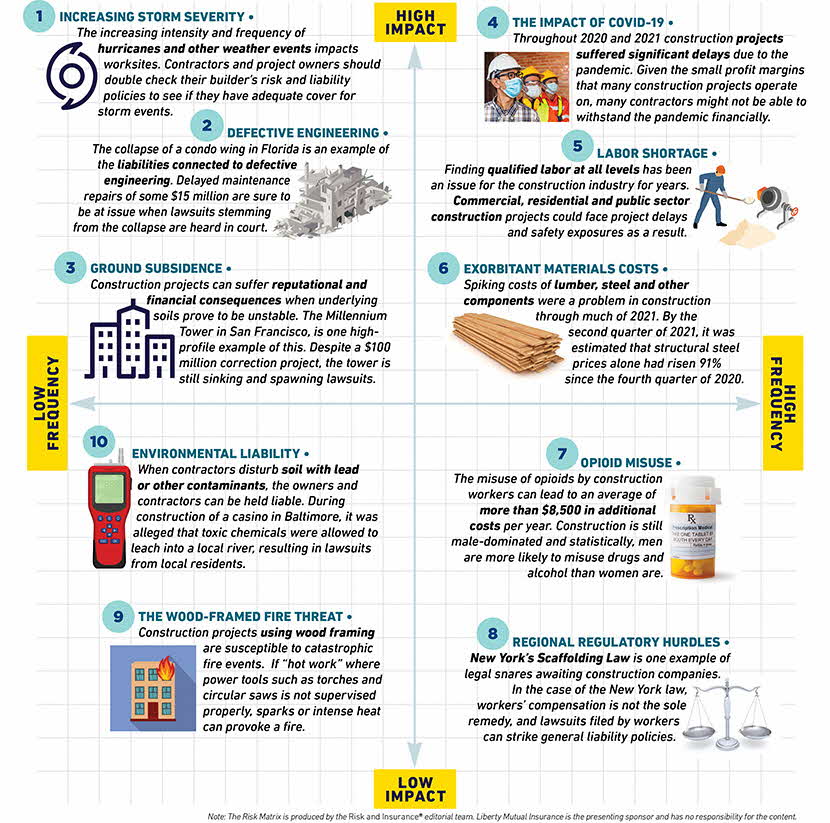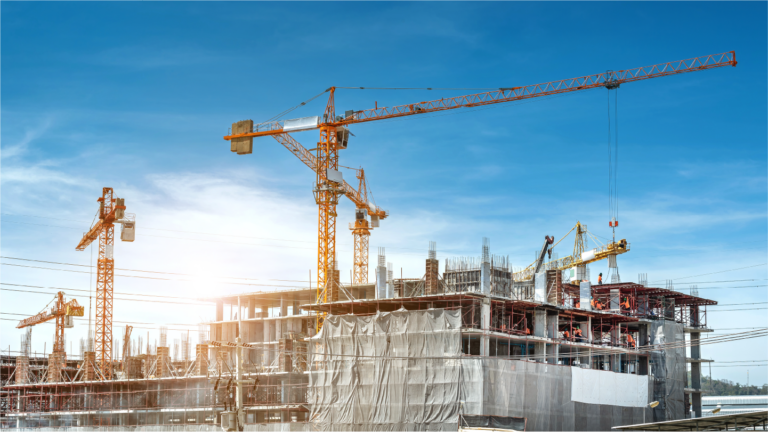
From climate change and COVID-19 to labor shortages and rising material costs, here are key risks to watch in the construction industry.
The Risk Matrix, produced by the editorial team at Risk & Insurance®, plots critical risks facing the construction sector based on the frequency and severity of each risk.
Increasing storm severity
The increasing severity of hurricanes and other weather events can impact the industry in several ways. Weather can damage existing structures, ongoing projects, materials, and equipment. Damage can be exacerbated in the event of significant power outages, for instance, the power grid failure in Texas in February 2021. Inaccessible work sites, inoperable equipment, unsafe working conditions, and supply chain problems are just a few of the risks that contractors may face. Any storm that leads to project delays or damaged building materials can lead to builder’s risk and construction defect exposures, which can negatively impact a company’s reputation and financials. To stay ahead, contractors should revisit their business continuity plans, maintain safety practices, review their builder’s risk policies, and take steps to guard against construction defect claims.
Defective engineering
The Surfside Condo collapse in Florida is one very high-profile example of the risks that can result when a project is beset by construction, engineering, or design flaws. In the current environment, with social inflation driving large claim payouts, the ongoing impacts of climate change, and design/build and modular construction projects becoming more common, it’s critical for contractors to manage potential liability exposures. Learn more about three steps to take to guard against construction defect claims.
Ground subsidence
Construction projects can suffer reputational and financial consequences when underlying soils are proven to be unstable. The subsidence of the foundation of the Millennial Tower in San Francisco, for example, represents not only a general liability exposure but also a significant reputational risk. As of this September, a $100 million repair project on the tower had to be suspended due to continued tilting and sinking. Investing in technology that can gather data on environmental risk factors, like soil conditions, the slope of the land, or the location on a potential flood plain, can help contractors create more resilient buildings that better withstand potential impacts of climate change.
The impact of COVID-19
Throughout 2020 and 2021 construction projects suffered significant delays due to the COVID-19 pandemic. According to a survey by Associated General Contractors of America (AGC), 52 percent of contractors say they’ve experienced a delay due to a shortage of materials, equipment, or parts. Given the small profit margins that many construction projects operate on, many contractors might not be able to withstand the pandemic financially. For some contractors, this has led to anxiety – and a temptation to chase business outside their normal territories or areas of expertise – and expose them to additional risk. Here are six strategies contractors can use to help reduce overhead, avoid unnecessary risk, and survive an unpredictable market.
Labor shortages
Finding qualified labor continues to challenge the construction industry. In fact, among contractors surveyed by AGC, 89 percent are having a hard time finding craft workers and 72 percent say available candidates are not qualified to work in the industry due to lack of skills or failure to meet other requirements. To address this shortage, firms are investing more in training, lowering hiring standards, leveraging career-building and online strategies to connect with younger applicants, and paying overtime. However, a deconditioned, unskilled, or burnt-out workforce can come with risks. A commitment to health, safety, and training should remain a key area of focus as companies begin returning to “business as usual.”
Exorbitant materials costs
Spiking costs of lumber, steel, and other components have been a problem in construction through much of 2021. By the second quarter of 2021, it was estimated that structural steel prices alone had risen 91 percent since the fourth quarter of 2020.
An overwhelming 93 percent of firms surveyed by AGC say rising materials costs have affected their projects. Contractors are trying to manage rising prices by passing a portion of costs to end customers, changing suppliers or specifications, or canceling orders. These higher prices are adding to the pressure on margins and are likely to have an impact on contractors’ bottom lines. Whether a project is priced correctly is a key discipline to delivering a construction project on time and on budget. Learn more about current pricing and supply chain challenges and strategies contractors can employ to help avoid potential risks and claims.
Opioid misuse
For the construction industry, the risk of opioid abuse among workers is relatively high. Employees in construction are almost twice as likely to have a substance use disorder as compared to the national average in other industries. In addition to taking a devastating personal toll on individuals and families, opioid misuse also negatively impacts companies.
Lost time, decreased job performance, on-the-job drug use, and poor morale are among many effects of prescription drug misuse experienced by employers. In fact, the misuse of opioids by construction workers can lead to an average of up to $8,500 in additional costs per year, according to the National Safety Council. There are steps construction companies can take to help reduce the risk and take care of employees, including promoting safe work practices, enacting strong company drug policies, and making employee assistance programs available to support workers.
Regional regulatory hurdles
Falls from heights, overexertion, and being struck by an object are the three leading causes of workplace injuries in the construction sector, costing more than $7 billion per year. Complicating matters for contractors and construction project owners is the fact that the “exclusive remedy” of workers compensation can sometimes be undermined by regional regulations. New York’s Scaffolding Law is one example — workers compensation is not the sole remedy for employees who suffer gravity-related injuries and claims can fall under general liability policies. An understanding of local and regional regulations and how they can impact liability is crucial in the construction sector.
The wood-framed fire threat
Although alternatives such as steel and aluminum framing exist, many construction projects rely on wood framing – including cross-laminated timber (CLT) construction, a building method in which wood is layered to create a strong and durable frame. However, wood frame-based construction projects can be susceptible to catastrophic fire events. For example, if “hot work” using power tools such as torches and circular saws is not supervised properly, sparks or intense heat can provoke a fire.
While CLT is growing in popularity, as it is sustainable, durable, lightweight, and suitable for prefabricated construction projects, it can also pose other risk-management challenges for owners, builders, and insurance providers.
Environmental liability
Construction projects can sometimes disturb contaminated soil or lead to the spread of contaminants via the air and waterways. In these cases, the contractor or project owner may be held liable. With the ongoing impact of social inflation, contractors and other construction project stakeholders should be on high alert for the presence of lead, PFAS, or other contaminants that could spur legal action if not properly monitored and contained.
Featured insights
This website is general in nature, and is provided as a courtesy to you. Information is accurate to the best of Liberty Mutual’s knowledge, but companies and individuals should not rely on it to prevent and mitigate all risks as an explanation of coverage or benefits under an insurance policy. Consult your professional advisor regarding your particular facts and circumstance. By citing external authorities or linking to other websites, Liberty Mutual is not endorsing them.
The Risk Matrix is featured with the permission of Risk & Insurance®. The Risk Matrix is produced by the Risk & Insurance editorial team.




